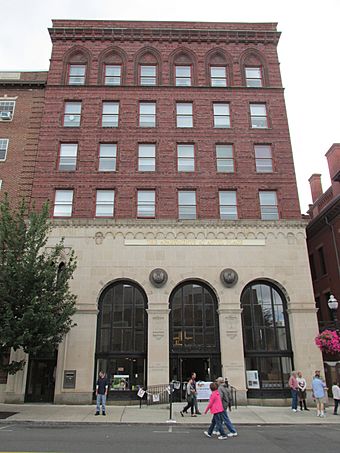Commercial Trust Company Building facts for kids
|
Commercial Trust Company Building
|
|
|
U.S. Historic district
Contributing property |
|
 |
|
| Location | 51-55 W. Main St., New Britain, Connecticut |
|---|---|
| Architect | Hopkins & Dentz |
| Part of | Downtown New Britain (ID16000210) |
| NRHP reference No. | 09000141 |
Quick facts for kids Significant dates |
|
| Added to NRHP | March 17, 2009 |
| Designated CP | May 3, 2016 |
The Commercial Trust Company Building is a special old building in downtown New Britain, Connecticut. People also call it the Anvil Building because of some cool decorations. Today, it's known as The Apartments at Anvil Place. This building was built in 1927 and shows off a unique style called Romanesque Revival, with some Gothic touches. It's so important that it was added to the National Register of Historic Places in 2009. It's also a key part of the Downtown New Britain historic area.
Contents
What Does the Anvil Building Look Like?
The Commercial Trust Company Building stands out right in the middle of New Britain. It's a tall, seven-story building made of stone and brick. The bottom three floors are covered in smooth limestone, giving it a grand look. These floors have three huge, rounded archways, mostly filled with glass. One of these arches holds a fancy bronze doorway that used to lead into the bank lobby.
Inside the Historic Bank Lobby
Step inside, and you'd find a lobby with very high ceilings and shiny marble floors. Even today, you can still see the old teller's counter where people used to do their banking!
The Upper Floors and Special Details
The top four floors of the building are made of brick. These floors now have apartments, but they still keep their historic charm. The windows on the very top floor have cool Gothic-style arches. The building also has a decorative brick design at the very top, called a corbelled cornice. Look closely at the outside, and you'll spot small blacksmith's anvils carved into the decorations. These anvils were a special symbol for the Commercial Trust Company.
A Look at the Building's History
This impressive building was finished in 1927. It was built for the Commercial Trust Company, a bank that started in 1915. This bank was created as a new option for people, different from the New Britain National Bank.
Who Designed This Building?
The architects who designed this building were Hopkins & Dentz from New York. They created a building that truly showed how successful and prosperous New Britain was in the 1920s.
Changes Over Time
Sadly, the good times didn't last forever. By 1929, the Great Depression began, which was a very tough time for the economy. The Commercial Trust Company faced difficulties and had to close its doors in December 1930. Later on, the New Britain National Bank bought the building. Today, it has been given a new life as apartments, keeping its history alive in downtown New Britain.



